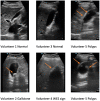Is gallbladder PoCUS diagnostic accuracy accessible to medical students after PoCUS training exclusively on healthy volunteers? A pilot randomized control trial
- PMID: 37036612
- PMCID: PMC10086079
- DOI: 10.1186/s13089-023-00317-6
Is gallbladder PoCUS diagnostic accuracy accessible to medical students after PoCUS training exclusively on healthy volunteers? A pilot randomized control trial
Abstract
Background: Point-of-care ultrasound (PoCUS) is increasingly used in clinical practice and is now included in many undergraduate curricula. Here, we aimed to determine whether medical students who participated in a PoCUS teaching program with several practical training sessions involving healthy volunteers could achieve a good level of diagnostic accuracy in identifying gallbladder pathologies. The intervention group (IG) was trained exclusively on volunteers with a healthy gallbladder, whereas the control group (CG) had access to volunteers with a pathological gallbladder as recommended in most PoCUS curricula.
Materials and methods: Twenty medical students were randomly assigned to the IG and CG. After completing the training program over 2 months, students were evaluated by three independent examiners. Students and examiners were blind to group allocation and study outcome. Sensitivity and specificity of students' PoCUS gallstone diagnosis were assessed. Secondary outcomes were students' confidence, image quality, acquisition time, and PoCUS skills.
Results: Sensitivity and specificity for gallstone diagnosis were, respectively, 0.85 and 0.97 in the IG and 0.80 and 0.83 in the CG. Areas under the curve (AUC) based on the receiver operating characteristic curve analysis were 0.91 and 0.82 in the IG and CG, respectively, with no significant difference (p = 0.271) and an AUC difference of -0.092. No significant between-group difference was found for the secondary outcomes.
Conclusions: Our pilot study showed that medical students can develop PoCUS diagnostic accuracy after training on healthy volunteers. If these findings are confirmed in a larger sample, this could favor the delivery of large practical teaching sessions without the need to include patients with pathology, thus facilitating PoCUS training for students.
Keywords: Clinical ultrasound; Curriculum; Point-of-care ultrasound; Ultrasound teaching.
© 2023. The Author(s).
Conflict of interest statement
All authors declare that they have no conflicts of interest.
Figures
Similar articles
-
Structured, Small-group Hands-on Teaching Sessions Improve Pre-clerk Knowledge and Confidence in Point-of-care Ultrasound Use and Interpretation.Cureus. 2018 Oct 23;10(10):e3484. doi: 10.7759/cureus.3484. Cureus. 2018. PMID: 30613446 Free PMC article.
-
Development of a hybrid point-of-care ultrasound curriculum for first year medical students in a rural medical education program: a pilot study.BMC Med Educ. 2024 Jan 3;24(1):16. doi: 10.1186/s12909-023-05005-6. BMC Med Educ. 2024. PMID: 38172848 Free PMC article.
-
Pre-clinical medical student cardiac point-of-care ultrasound curriculum based on the American Society of Echocardiography recommendations: a pilot and feasibility study.Pilot Feasibility Stud. 2021 Sep 14;7(1):175. doi: 10.1186/s40814-021-00910-3. Pilot Feasibility Stud. 2021. PMID: 34521479 Free PMC article.
-
Is it time to include point-of-care ultrasound in general surgery training? A review to stimulate discussion.ANZ J Surg. 2013 Dec;83(12):908-11. doi: 10.1111/ans.12363. Epub 2013 Aug 26. ANZ J Surg. 2013. PMID: 23980756 Review.
-
The Effectiveness of Different Teaching Modalities for the Detection of Heart Murmurs in Undergraduate Medical Education: A Review.Cureus. 2024 Jan 26;16(1):e53013. doi: 10.7759/cureus.53013. eCollection 2024 Jan. Cureus. 2024. PMID: 38410315 Free PMC article. Review.
References
-
- Totenhofer R, Luck L, Wilkes L. Point of care ultrasound use by registered nurses and nurse practitioners in clinical practice: an integrative review. Collegian août. 2021;28(4):456–463. doi: 10.1016/j.colegn.2020.10.002. - DOI
LinkOut - more resources
Full Text Sources



